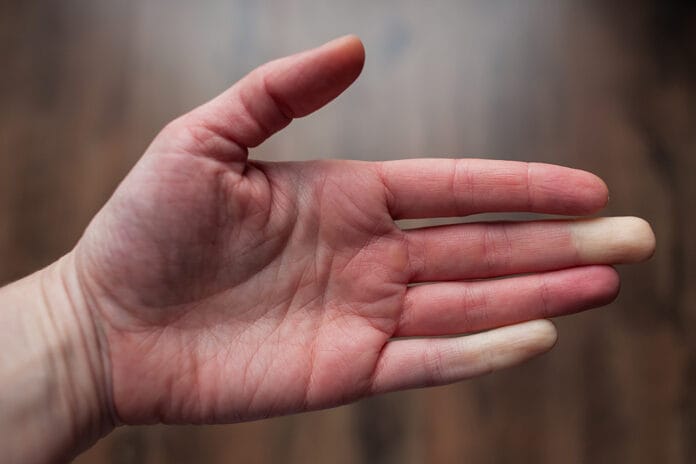Dental professionals frequently report musculoskeletal pain, especially in the upper extremities. A study published in 2021 showed that 92.6% of participants (n=229 dentists) suffered from musculoskeletal disorders in at least one body region.1 In contrast, a study focusing on hygienists (n=647 dental hygienists) found that 83% reported work-related musculoskeletal pain, primarily in the hands and arms (carpal tunnel and tendonitis).2
Though we know the importance of ergonomics, poor ergonomics may not be the only factor contributing to arm and hand pain that dental hygienists should consider. Another offender that needs to be recognized and addressed is the hand-arm vibration syndrome. Hand-arm vibration syndrome is when exposure to vibrating hand-held tools causes vascular and neuromuscular symptoms.
Dental professionals are at risk of acquiring hand-arm vibration syndrome because they frequently use handpieces that produce high-frequency vibrations.3
Identify Signs of Vibration Syndrome Early
The tendency to develop injuries associated with vibrations varies among individuals. Much like musculoskeletal disorders, some individuals are more susceptible than others. Once the vibration injury is fully developed, it is irreversible.
For this reason, it is important to recognize the signs early and practice prevention. Specific tools that are cited in the acquisition of hand-arm vibration syndrome specific to dental hygiene include handpieces and ultrasonic scalers.3 Early signs and symptoms include tingling and/or numbness in the hands and fingers, which can progress to limited dexterity and tactile sensitivity. Carpal tunnel is classified as a neurological vibration injury as well.
Vascular injuries due to vibration syndrome cause vasospasms, which present as blanching often triggered by cold. Other terms used to describe this are vibration-induced white fingers” or “secondary Raynaud’s disease.”3 Further possible connections between finger blanching and hearing loss have been reported. This is an interesting angle as both finger blanching and hearing loss are common in dental professionals. The connection is postulated to be associated with sympathetic vasoconstriction.4
Additionally, Raynaud’s disease is associated with migraines and cardiovascular disease, though this tends to be more evident in primary Raynaud’s disease rather than secondary Raynaud’s disease.5
Reducing the Risk
In addition to awkward working postures, hand-arm vibration exposure is associated with shoulder and neck pain, areas often reported by dental hygienists as areas of consistent pain.6 Though we often pay close attention to posture and other aspects of ergonomics, being mindful of the effect vibrations have on musculoskeletal disorders (MSDs) is important to reduce the overall risk.
According to The National Institute for Occupational Safety and Health (NIOSH), work practices to adopt that will reduce the risk of hand-arm vibration syndrome include the following:7
- Vibrating hand tools should be carefully maintained according to the manufacturers’ recommendations.
- Schedule 10-minute breaks after each hour of continuous exposure.
- Manage body temperature. Low body temperature reduces blood flow to the extremities. Therefore, if your office is often cold, dress appropriately.
- Let the tool do the work; grasp it as lightly as possible. The tighter the tool is held, the greater the vibration transmitted to the worker.
- Substitute manual tools where practical. NIOSH suggests this; however, I personally don’t think it is applicable to dental hygiene practices as hand scaling may cause more hand fatigue.
Dental professionals are taught early about the risks of MSDs associated with the profession. Tons of products and new equipment are being manufactured to extend the length of the career. However, there are still high rates of early retirement due to MSDs. Having a comprehensive understanding of all aspects of the dental profession that can contribute to MSD onset and progression is important in managing risk factors.
The top suggestions for better ergonomics thus far include loupes, saddle chairs, and ergonomic equipment that reduces the need to bend, stretch, and reach in awkward positions. Add to the list the need to be aware of the use of vibrating tools, the need for regular breaks, and proper body temperature.
Most dental professionals don’t want to retire early, and if they do, they don’t want it to be due to an MSD. Take precautions and take care of your body. I’m hoping to see more long, pain-free careers for all dental professionals.
Before you leave, check out the Today’s RDH self-study CE courses. All courses are peer-reviewed and non-sponsored to focus solely on high-quality education. Click here now.
Listen to the Today’s RDH Dental Hygiene Podcast Below:
References
- Rickert, C., Fels, U., Gosheger, G., et al. Prevalence of Musculoskeletal Diseases of the Upper Extremity Among Dental Professionals in Germany. Risk Manag Healthc Policy. 2021; 14: 3755-3766. https://www.ncbi.nlm.nih.gov/pmc/articles/PMC8443801/
- Harris, M.L., Sentner, S.M., Doucette, H.J., Brillant, M.G.S. Musculoskeletal Disorders among Dental Hygienists in Canada. Can J Dent Hyg. 2020; 54(2): 61-67. https://www.ncbi.nlm.nih.gov/pmc/articles/PMC7668274/
- Chowdhry, R., Sethi, V. Hand-arm Vibration Syndrome in Dentistry: A Review. Current Medicine Research and Practice. 2017; 7(6): 235-239. https://www.sciencedirect.com/science/article/abs/pii/S2352081717301411
- Palmer, K.T., Griffin, M.J., Syddall, H.E., et al. Raynaud’s Phenomenon, Vibration Induced White Finger, and Difficulties in Hearing. Occup Environ Med. 2002; 59(9): 640-642. https://oem.bmj.com/content/59/9/640
- Garner, R., Kumari, R., Lanyon, P., et al. Prevalence, Risk Factors and Associations of Primary Raynaud’s Phenomenon: Systematic Review and Meta-analysis of Observational Studies. BMJ Open. 2015; 5(3): e006389. https://www.ncbi.nlm.nih.gov/pmc/articles/PMC4368987/
- Charles, L.E., Ma, C.C., Burchfiel, C.M., Dong, R.G. Vibration and Ergonomic Exposures Associated with Musculoskeletal Disorders of the Shoulder and Neck. Safety and Health at Work. 2018; 9(2): 125-132. https://www.ncbi.nlm.nih.gov/pmc/articles/PMC6005913/
- Vibration Syndrome. (2014, June 6). Centers for Disease Control and Prevention: The National Institute for Occupational Safety and Health. https://www.cdc.gov/niosh/docs/83-110/default.html












